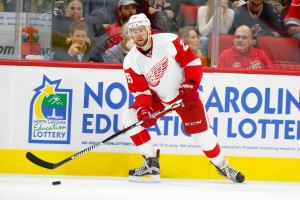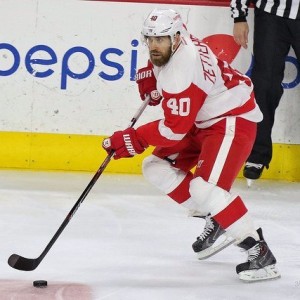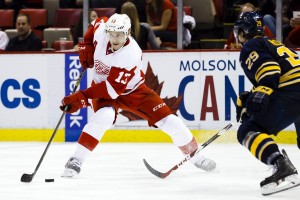How the Detroit Red Wings Can Reboot Their Maligned Power Play
Last month, the Detroit Red Wings scored 10 power play goals and finished the month 11th in the league in power play percentage. To start the New Year, the Red Wings have gone 1-for-10 with the man advantage and are in need a refresh. To fix the power play, they should look no further than Eastern Conference foe, the Washington Capitals, for a power play scheme that will deliver.
Currently tied for second in the NHL with a 26.6% power play conversion rate, the Capitals use an overload power play set up with an exaggerated weak-side shooter. That shooter they feature is none other than Mr. 500 himself, Alex Ovechkin.
Breaking Down the Capitals’ Power Play
Here’s how the Capitals’ overload power play works:
In the video above, the Capitals utilized the following:
- Shooter: Ovechkin (8)
- Quarterback: Matt Niskanen (2)
- Half Wall Playmaker: Andre Burakowsky (65)
- Goal Line Passer: Jason Chimera (25)
- Slot Shooter: Justin Williams (14)
Once Teemu Pulkkinen returns from injury, the Detroit Red Wings will have a lineup composition to match the man advantage scheme used by the Capitals. Here’s how:
1. Shooter

PP1: Teemu Pulkkinen
PP2: Tomas Tatar
Like Ovechkin, Pulkkinen features a booming, right-handed shot. And though he is not as skilled as the newest member of the 500-goal club, Pulkkinen has the ability to do some damage if he is left alone on the far side. The goal of this overload scheme is to draw the penalty killers to the strong side and allow the shooter to find space—either on the half wall or down low—and fire the puck home when he is passed to. If you watch the Capitals’ power play, the puck often does not reach Ovechkin until he is primed to shoot. The other players pass the puck around until all four penalty killers are on their side.
Though Tatar is left-handed and will not be able to shoot too many one-timers, the Red Wings have previously featured him on the weak side in an attempt to create space for his blistering wrist shot. He will certainly experience success in this role if he has forward momentum toward the goal when taking a pass. His elusiveness and timing by the passers are the keys to success. Dylan Larkin would also be effective in this role of Jeff Blashill opts to put him there.
2. Quarterback

PP1: Mike Green
PP2: Niklas Kronwall
Who better to quarterback the Red Wings’ top power play than the original power play quarterback for the Capitals, Mike Green. Green starred as the Capitals’ quarterback for years before signing with the Detroit Red Wings this offseason. He certainly knows how to free up a right-handed cannon on his left while working the point.
Niklas Kronwall presents a different type of quarterback, but one that will be effective nonetheless. His shot is not the most powerful, but can find its way to the net just like his mentor, Nicklas Lidstrom. Kronwall’s vision is also dangerous, in that he can draw a penalty killer to try to block the shot and quickly pass it over to a streaking Tatar.
3. Half Wall Playmaker

PP1: Henrik Zetterberg
PP2: Brad Richards
In this power play set up, the playmaker needs to have immaculate vision and awareness, as they are the true key to the power play. Zetterberg and Richards will both hold the puck more on their respective power play units than anyone else on the ice. They have the option to walk in and shoot if the defense is playing passively against them. Zetterberg and Richards also have the freedom to walk in and dish the puck off as one or two defenders are closing in. They decide the fate of how the power play will operate. Either it will work down low, up high, or a combination of both, depending on how the penalty kill aligns. The play funnels through the playmaker regardless.
4. Goal Line Passer

PP1: Pavel Datsyuk
PP2: Riley Sheahan
In the role of the goal line passer, the player is responsible for:
- Rotating with the playmaker to cause confusion with the penalty kill
- Feeding the playmaker, shooter, and slot shooter
- Bad angle, surprise shots
- Tipping pucks, when necessary
Pavel Datsyuk is perfect for this role. His excellent vision and tape-to-tape, no-look passes will haunt defenses and goalies as they try to defend his creativity. The Magic Man is also a prime candidate to send cross-rink feeds to a waiting Pulkkinen on the weak side, especially at a time when the penalty killers won’t expect it. While in possession of the puck, penalty killers will want to collapse on him, freeing up the overload shooters.
Though not particularly known for his passing abilities, Riley Sheahan can fit the role the Jason Chimera currently plays for the Capitals. Along with making passes when prompted to, Chimera will often rotate up to the top of the crease and immobilize himself with defenders trying to move him. This creates an additional screen and the opportunity for him to plant his stick on the ice where a shot-pass will deflect into the net whenever it makes contact. Sheahan can thrive in this role for the Detroit Red Wings and add his own special play as well:
https://youtu.be/aKTOP02moUQ
5. Slot Shooter

PP1: Justin Abdelkader
PP2: Gustav Nyquist
Finally, the slot shooter is tasked with finding space in either the box or diamond penalty kill set up that the defense uses to defend the overload. On the top power play, Justin Abdelkader can use his size to screen the goaltender when the puck is up high or rotate into the slot when the puck is down low. Because he is left-handed, Abdelkader will have to open up more to receive a pass from either Zetterberg or Datsyuk. He also has the ability to redirect a shot-pass to the net when the playmaker is working up high.
Gustav Nyquist has the potential to thrive in this role, especially if the play is worked over to the weak side. Tatar can quickly reverse the flow of the play back to Nyquist in the slot if he has no clear shot on net. Nyquist will be just as dangerous as Tatar in this set up because of his strong shooting and ability to receive and do something with passes from the four other players.
Final Word
Detroit’s puck-possession style of offense translates perfectly into success using this power play set up. Though the roles explained above best suit the suggested players, the Red Wings have a luxury of talent in their lineup and allows them feature several players in different positions in an attempt to create new looks. The only caveat is that this style of power play takes time to learn, so the Red Wings may face struggles trying to implement it. Additionally, as the trade deadline approaches, the Detroit Red Wings may find themselves trading a player on one of the two power plays in an attempt to solidify their roster. This also comes with the possibility of adding a player that is perfectly suited for one of the five power play roles.
—